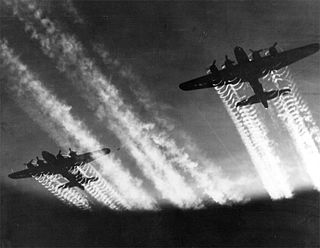Military strategy is a set of ideas implemented by military organizations to pursue desired strategic goals. Derived from the Greek word strategos, the term strategy, when first used during the 18th century, was seen in its narrow sense as the "art of the general", or "'the art of arrangement" of troops. and deals with the planning and conduct of campaigns, the movement and disposition of forces, and the deception of the enemy.

The Schlieffen Plan is a name given after the First World War to German war plans, due to the influence of Field Marshal Alfred von Schlieffen and his thinking on an invasion of France and Belgium, which began on 4 August 1914. Schlieffen was Chief of the General Staff of the German Army from 1891 to 1906. In 1905 and 1906, Schlieffen devised an army deployment plan for a decisive (war-winning) offensive against the French Third Republic. German forces were to invade France through the Netherlands and Belgium rather than across the common border.

A Pyrrhic victory is a victory that inflicts such a devastating toll on the victor that it is tantamount to defeat. Such a victory negates any true sense of achievement or damages long-term progress.
Attrition warfare is a military strategy consisting of belligerent attempts to win a war by wearing down the enemy to the point of collapse through continuous losses in personnel and materiel. The word attrition comes from the Latin root atterere, meaning "to rub against", similar to the "grinding down" of the opponent's forces in attrition warfare.

The German spring offensive, or Kaiserschlacht, also known as the Ludendorff offensive, was a series of German attacks along the Western Front during the First World War, beginning on 21 March 1918. Following American entry into the war in April 1917, the Germans decided that their only remaining chance of victory was to defeat the Allies before the United States could ship soldiers across the Atlantic and fully deploy its resources. The German Army had gained a temporary advantage in numbers as nearly 50 divisions had been freed by the Russian defeat and withdrawal from the war with the Treaty of Brest-Litovsk.

Victory disease occurs in military history when complacency or arrogance, brought on by a victory or a series of victories, makes an engagement end disastrously for a commander and his forces.

A counterattack is a tactic employed in response to an attack, with the term originating in "war games". The general objective is to negate or thwart the advantage gained by the enemy during attack, while the specific objectives typically seek to regain lost ground or destroy the attacking enemy.

There is widespread disagreement among historians about the turning point of the American Civil War. A turning point in this context is an event that occurred during the conflict after which most modern scholars would agree that the eventual outcome was inevitable. The Battle of Gettysburg in July 1863 is the battle most widely cited as the military climax of the American Civil War. Several other decisive battles and events throughout the war have been proposed as turning points. The events are presented here in chronological order with only the positive arguments for each is given.
Annihilation is a military strategy in which an attacking army seeks to entirely destroy the military capacity of the opposing army. This strategy can be executed in a single planned pivotal battle, called a "battle of annihilation". A successful battle of annihilation is accomplished through the use of tactical surprise, application of overwhelming force at a key point, or other tactics performed immediately before or during the battle.

Operation Flash was a brief Croatian Army (HV) offensive conducted against the forces of the self-declared proto-state Republic of Serbian Krajina (RSK) from 1–3 May 1995. The offensive occurred in the later stages of the Croatian War of Independence and was the first major confrontation after ceasefire and economic cooperation agreements were signed between Croatia and the RSK in 1994. The last organised RSK resistance formally ceased on 3 May, with the majority of troops surrendering the next day near Pakrac, although mop-up operations continued for another two weeks.
Operation Maslenica was a Croatian Army offensive launched in January 1993 to retake territory in northern Dalmatia and Lika from Krajina Serb forces, with the stated military objective of pushing the Serbs back from approaches to Zadar, Maslenica and Karlobag, allowing a secure land route between Dalmatia and northern Croatia to be opened. While an undoubted net Croatian tactical success, the operation was only a moderate strategic success, and was condemned by the UN Security Council.
Deep operation, also known as Soviet Deep Battle, was a military theory developed by the Soviet Union for its armed forces during the 1920s and 1930s. It was a tenet that emphasized destroying, suppressing or disorganizing enemy forces not only at the line of contact but also throughout the depth of the battlefield.

The eastern theater of the American Civil War consisted of the major military and naval operations in the states of Virginia, West Virginia, Maryland, and Pennsylvania, the District of Columbia, and the coastal fortifications and seaports of North Carolina.

The military history of the United States during World War II covers the nation's role as one of the major Allies in their victory over the Axis Powers. The United States is generally considered to have entered the conflict with the 7 December 1941 surprise attack on Pearl Harbor by the Empire of Japan and exited it with the 2 September 1945 surrender of Japan. During the first two years of World War II, the US maintained formal neutrality, which was officially announced in the Quarantine Speech delivered by US President Franklin D. Roosevelt in 1937. While officially neutral, the US supplied Britain, the Soviet Union, and China with war materiel through the Lend-Lease Act signed into law on 11 March 1941, and deployed the US military to replace the British forces stationed in Iceland. Following the 4 September 1941 Greer incident involving a German submarine, Roosevelt publicly confirmed a "shoot on sight" order on 11 September, effectively declaring naval war on Germany and Italy in the Battle of the Atlantic. In the Pacific Theater, there was unofficial early US combat activity such as the Flying Tigers.
A decisive victory is a military victory in battle that definitively resolves the objective being fought over, ending one stage of the conflict and beginning another stage. Until a decisive victory is achieved, conflict over the competing objectives will continue.

Operation Summer '95 was a joint military offensive of the Croatian Army (HV) and the Croatian Defence Council (HVO) that took place north-west of the Livanjsko Polje, and around Bosansko Grahovo and Glamoč in western Bosnia and Herzegovina. The operation was carried out between 25 and 29 July 1995, during the Croatian War of Independence and the Bosnian War. The attacking force of 8,500 troops commanded by HV's Lieutenant General Ante Gotovina initially encountered strong resistance from the 5,500-strong Army of Republika Srpska (VRS) 2nd Krajina Corps. The HV/HVO pushed the VRS back, capturing about 1,600 square kilometres of territory and consequently intercepting the Knin—Drvar road—a critical supply route of the self-declared Republic of Serbian Krajina (RSK). The operation failed to achieve its declared primary goal of drawing VRS units away from the besieged city of Bihać, but it placed the HV in position to capture the RSK's capital Knin in Operation Storm days later.

The Split Agreement or Split Declaration was a mutual defence agreement between Croatia, the Republic of Bosnia and Herzegovina and the Federation of Bosnia and Herzegovina, signed in Split, Croatia on 22 July 1995. It called on the Croatian Army (HV) to intervene militarily in Bosnia and Herzegovina, primarily in relieving the siege of Bihać.










